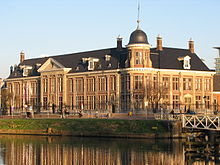- Royal Dutch Mint
-
Koninklijke Nederlandse Munt Type Naamloze vennootschap owned by Dutch government only Industry coin production Founded 1567, Utrecht Headquarters Utrecht, Netherlands Area served Worldwide Key people Maarten Brouwer (mint master) Products coins / medals Website www.knm.nl/ (Dutch) The Koninklijke Nederlandse Munt (Royal Dutch Mint), seated in Utrecht, the Netherlands, is a company owned entirely by the Dutch State, and since 1807 the only Dutch entity allowed to strike and give out coins.
History
On 17 September 1806 (The Netherlands were under the rule of King Louis Napoleon) Louis Napoleon decided that the striking and distribution of coins should be by a single, national body[1]. This was in contrast to the Middle Ages customs of large trading cities to have their own mint and coins. This resulted in several coins circulating within the country, and many levels of controlling bureaucracy.
Originally it was the intention to found the mint in the capital city of Amsterdam but, since there were insufficient financial means available, it was decided to locate the National Mint seat in Utrecht.
After Napoleon was defeated in 1813, and the Kingdom of the Netherlands was founded with William I as King, the Mint was renamed to 's Rijks Munt. What is now known as Belgium was a part of the new kingdom, and a second Mint was located in Brussels[2]. Once Belgium achieved independence in 1839, 's Rijks Munt became the only mint in the Kingdom of the Netherlands. The provincial coins which were made before the unification of the Mint were still in circulation. Due to their relatively high intrinsic value, the "new" coins would only gain popularity with the passage of time. In 1849 the provincial coins were officially taken out of the circulation.
In 1901[3] the company was placed under supervision of the Ministry of Finance, and in 1912 the Mint officially became a company owned by the State. [4]. At the end of the German occupation during the Second World War, in 1944, coins were produced in the United States. This was necessary to make sure there would be sufficient currency available after the liberation[5].
In 1994 's Rijks Munt was renamed to De Nederlandse Munt NV. It became a company, of which 100% of the shares are owned by the Dutch State. The Queen awarded the company the prefix Koninklijk (Royal) five years later, and the company was now allowed to call itself De Koninklijke Nederlandse Munt (The Royal Dutch Mint)[6].
Production
Since 2002 the Royal Dutch Mint has been allowed to strike coins for foreign national banks in the euro zone, and strikes coins for Latvia, Guatemala and Honduras. Furthermore, the Dutch Royal Mint produces memorial and collection coins (sometimes an official coin, sometimes not) and royal medals.[7]
The Royal Dutch Mint was also delegated the task of destroying the old guilders after their replacement by the euro in 2002.
Sources and references
- ^ By Royal decrete no. 18
- ^ website on the Dutch guilder about the coins in the era of William I
- ^ Law of 28 May 1901, State Courant No 130
- ^ Website on the Dutch guilder, during the reign of Wilhelmina (Dutch)
- ^ Royal Decrete 20 July 1944, State Courant E54 and E55)
- ^ Website about the Dutch Guilder describing the change from 's Rijks Munt to Koninklijke Nederlandse Munt
- ^ Website of the Royal Dutch Mint on market shares (Dutch)
- elaborating about the Royal Dutch Mint (in English)

Dutch Rijksmonument 514180 Categories:- Government-owned companies
- Companies of the Netherlands
- Mints
- Organisations based in the Netherlands with royal patronage
- Rijksmonuments in Utrecht (city)
- Coin stubs
- Dutch building and structure stubs
Wikimedia Foundation. 2010.

